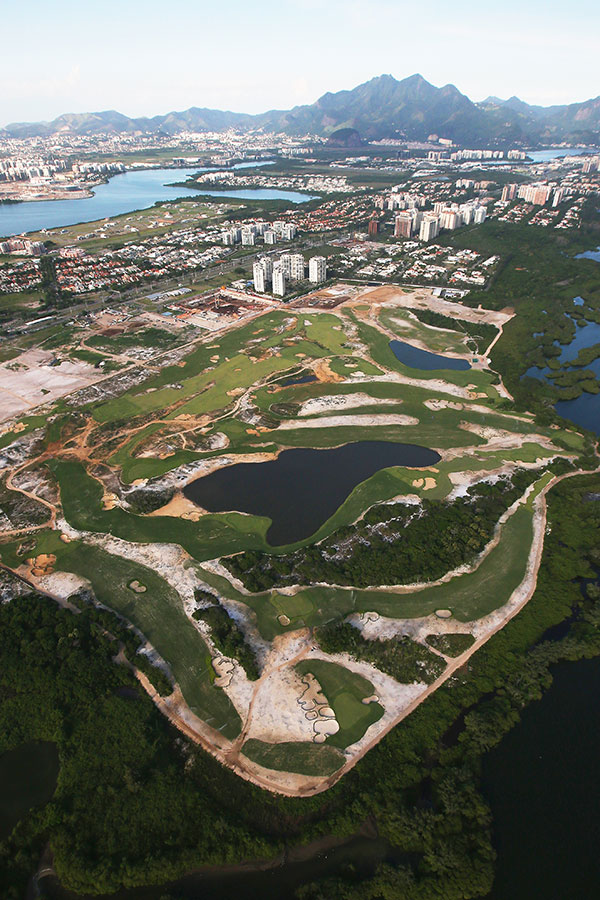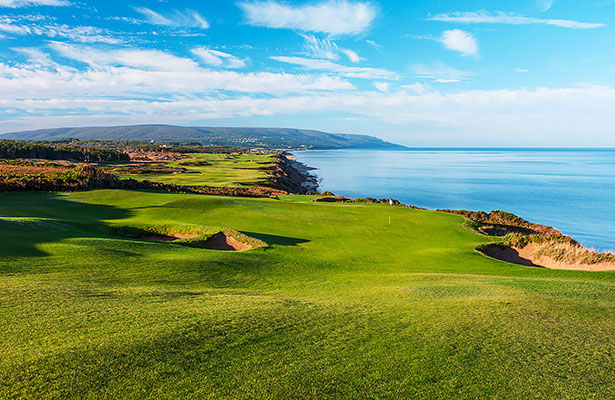Melbourne golf course shaper Ben Hillard was hand-picked to help build Brazil’s much-anticipated 2016 Olympic course. Yet the 30-year-old can’t strike gold on Aussie soil.
WHEN US course designer Gil Hanse won the bid to design the golf course for the 2016 Rio Olympics, he was ecstatic. “I think stunned is the right word,” Hanse said. But he had a dilemma. Hanse had never been to Australia, yet he had sold the concept of a Sandbelt-style layout to the International Golf Federation for the Brazilian site they’d selected as the Olympic golf venue. Set near the ocean in the Barra de Tijuca region of Rio de Janeiro, the property features some gently rolling sand dunes and vegetation reminiscent of what you find in Melbourne’s revered golfing region.
For Hanse and his design associates, the priority after winning the Olympic contract was to visit the Sandbelt and study some of our most celebrated layouts. During a tour of Australia in early 2013, the designers spent time at a number of leading golf clubs, looking at various features that would underpin their Olympic design.
The next step for Hanse was to put together a construction team capable of physically building the golf course. Young Aussie shaper Ben Hillard, from Melbourne, was one selected. Hillard is now 30 and with a couple of major international projects under his belt.
A graduate of the University of Melbourne with a degree in Landscape Architecture, Hillard is part of the new wave of golf course shapers. These up-and-comers are prepared to travel to foreign fields and gain the experience required in this highly competitive industry. Hillard started out at the Ivanhoe (public) Golf Course in Melbourne, working part-time on the maintenance team. He then travelled to Scotland and the Home of Golf, where he was a greenkeeper for the St Andrews Links Trust. Following a stint back in Australia at Ratho Farm in Bothwell, Tasmania, he worked at Cabot Links in Nova Scotia, Canada for two years. There he transitioned from greenkeeping to his passion – course construction.
In a short career span, Hillard has established himself as a sought-after shaper, having worked with respected designers such as Hanse and Bill Coore. At home in Australia between jobs in South America and the US, Hillard sat down with Australian Golf Digest to discuss the Rio course, his career , and hopes for the future.

Australian Golf Digest: Describe your background in golf, how you got into the game and ended up shaping golf courses?
Ben Hillard: My first taste of golf was following my father around the golf course with a cut-down iron when I was six or seven years old. But I didn’t truly fall in love with the game and the architectural side until I was 21. I joined Rosanna Golf Club (in Melbourne), played a ton of golf and played on the pennant team for three years. I finished uni in 2010, when the golf industry was at a standstill. I wanted to develop a worldwide appreciation for golf and after some advice from architects, I applied for greenkeeping jobs in the UK. After two years of maintaining courses in Australia, Scotland and Canada (and seeing around 200 courses) I got my dream start – working on Cabot Cliffs, a Bill Coore and Ben Crenshaw design.
After a stint at home to catch up on some Australian sunshine, Hanse offered me a job on his team for the Rio 2016 Olympic Golf Course, where I’ve spent the past 14 months. While in Rio de Janeiro, I also got the opportunity to work at the Gavea Golf and Country Club.
AGD: Hanse’s concept was sold to the International Golf Federation on the premise it would resemble the Sandbelt layouts. Describe how Hanse has stayed true to that design philosophy – how do you think it reflects the Sandbelt, and how does it differ?
BH: The most obvious similarities to the Sandbelt would be the bunkering and also that one of the par 3s was inspired by the 16th hole of Royal Melbourne’s West Course. But there are other elements like the short grass surrounds, the shaping of the greens, use of long and short holes bordering on different pars and the importance of course management, which is paramount on the Sandbelt. But it is also its own golf course and the site dictates the flow and character of the course. One of the biggest differences with the Sandbelt would be that there are five holes bordered by lakes.
AGD: To what degree did Hanse call upon your knowledge base to shape the Aussie elements of the Olympic course, seeing as you grew up in Melbourne?
BH: Everyone on the Olympic project (Hanse, Jim Wagner, Neil Cameron, Kyle Franz, Ben Warren and myself) has spent time on the Sandbelt and developed a feel for how they could shape Sandbelt-type features. One advantage of being from Melbourne is that I could refresh my inspiration from the Sandbelt before I started in Rio and then again during my trips home.
AGD: In regards to your own input on the Olympic course, are there elements or features you can look at and say, “That was my idea, or my work or my suggestion that Gil ran with?”
BH: I certainly hope after a year’s work there is something out there that I worked on! But in terms of ideas and suggestions, I enjoyed being part of the conversations in the decision-making process. The whole team would take part in on site discussions. Someone would throw out an idea to be discussed and the final concept would be decided on by all of us and approved by Gil. The shaping of the course really was a team effort. For example, the process for building a bunker would be: rough shaped by a dozer; detail shaped with an excavator; finer shaped with a mini excavator; have the lips hand made (stacked sod wall); have the face and base shaped by excavator; and then finished by hand. It’s quite a lengthy process and sometimes each member of our team was involved in one or more of the steps.
AGD: Describe your day-to-day duties shaping the Olympic course for those golfers who don’t quite know what a shaper is?
BH: For most people ‘shaping’ refers to the use of varying sizes of machinery, as well as hand tools, to build and detail the architectural elements of a golf course. However, depending on the stage of the project there are any number of jobs you can find yourself doing, including building and removing haul roads, hand raking areas directly before grassing or transplanting trees.
A typical week for us in Rio was Monday to Saturday and about 60 hours a week. I spent most of my time working on the bunkers, native grass areas and preparing green surrounds for grassing. But towards the end of a project it is all hands on deck as much as possible to make sure everything is getting done and each part of the process (shaping, irrigation and planting) is happening.
AGD: The course was reported to be behind schedule. How did this affect your role as a shaper and were you under pressure?
BH: Any major delays in the project were before my involvement. And honestly, it was perfect for me because I had work commitments in Canada and any delays meant that I could be involved in both the Olympic project and at Cabot Cliffs.
AGD: Describe the Olympic course in general. A course on a nature reserve in Barra da Tijuca, on sand dunes close to the ocean, with inspiration from the Sandbelt sounds breathtaking?
BH: You’ve set the scene pretty well already. The course doesn’t have much elevation change but it’s almost always moving which means you won’t find many flat lies. Unfortunately, you can’t see the ocean and there are only hints of the Marrapedi Lagoon. But the mountains, Olympic village and surrounding apartment towers make for a very unique and spectacular city golf setting.
AGD: In your mind, what makes a good quality shaper?
BH: Passion! Shaping a golf course is a huge job where acres of land are worked on over months or even years. Being passionate about your work and the game of golf is key to getting the most out of the site and delivering the best possible golf experience.
AGD: What sort of freedom do Gil Hanse and Bill Coore afford their shaping crews?
BH: Both Gil and Bill give their teams a lot of freedom and are receptive to their input. They encourage their shapers to try different things but will also reel their teams back in if required. They both have very talented teams of shapers. While I have learnt a lot from both Gil and Bill, I have also learnt a lot from their shapers.
AGD: Is your ultimate goal to be a lead shaper, or a guy that can design and build?
BH: Right now I love the path I’m on. The learning curve is really steep and the experiences that come with working internationally are amazing. I want to keep shaping and take on more responsibility with projects. Hopefully I’ll get the opportunity to do some design work in the future.
AGD: You’ve worked mostly on good land, are you eager to test yourself on difficult sites?
BH: I think everyone in the industry would love to work on good land all the time. But some amazing golf courses have also been built on average land. Working on difficult sites can force you to come up with some creative solutions and some really unique golf. I think it would be a good challenge and a great experience.
AGD: What type of opportunities do you see for Australian shapers in the years ahead?
BH: I doubt we are going to see a boom in the business in the near future. But I believe there will be more opportunities over the next few years. As long as you’re willing to travel to where the action is, there are plenty of opportunities out there for shapers. And hopefully there will be some exciting projects coming up in Australia.
AGD: Is it frustrating to have to head overseas to work on quality projects?
BH: No, the past five years have given me a worldwide understanding of golf. The projects, people and teams I’ve worked with have been the best I could hope for.
AGD: Finally, how do you see the local Australian industry at the moment? What can we learn from how you’ve seen things done overseas?
BH: It seems the local industry is starting to pick up. It’s great to see more courses undergoing renovation or restoration work. I wouldn’t critique the guys in the industry that are much more experienced than myself. But if I had to comment on the different approaches between work done in Australia and abroad, the teams I’ve worked with have really focussed on the last 10 per cent of the project. When the end goal of the project is permanence, really nailing the finishing touches is crucial.

Darius Oliver is a golf course design consultant and the author of Planet Golf and Planet Golf USA, which are available via planetgolf.com.au



